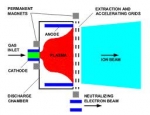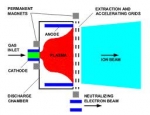Displaying items by tag: Hughes Space and Communications
XIPS - Xenon Ion Propulsion System
XIPS is a com-mercial electron bom-bardment thruster (also known as an electrostatic ion thruster) – a form ion propulsion – that is a product of Hughes Space and Communications Company, which, in 2000, became part of Boeing Satellite Systems.
XIPS (pronounced "zips") employs the heavy inert gas xenon as a propellant. It was first used operationally aboard the PAS-5 (PanAmSat-5) communications satellite in 1997 and has since been fitted to many other geosynchronous satellites for use primarily in station-keeping. In a XIPS, xenon atoms are injected into an ionization chamber and ionized by electron bombardment. The propellant is then electrostatically accelerated through a series of biased grids. Ions, ejected by XIPS, travel in a stream at a speed of 30 km/s (62,900 mph), nearly 10 times that of a conventional chemical thruster. The high efficiency of the system leads to a reduction in propellant mass of up to 90% for a satellite designed for 12–15 years operation.
For example on a XIPS equipped Boeing 702 satellite, four 25-cm thrusters provide economical station keeping, needing only 5 kg of fuel per year. Boeing asserts that this is "a fraction of what bipropellant or arcjet systems consume". Boeing further asserts, that a XIPS can be used for final orbit insertion and has orders ( source: Wikipedia, Boeing_702 ) for spacecraft utilizing only ion thrusters. This conserves even more payload mass, as compared to using an on-board liquid apogee engine.
XIPS - Xenon Ion Propulsion System
XIPS is a commercial electron bombardment thruster (also known as an electrostatic ion thruster) – a form ion propulsion – that is a product of Hughes Space and Communications Company, which, in 2000, became part of Boeing Satellite Systems.
XIPS (pronounced "zips") employs the heavy inert gas xenon as a propellant. It was first used operationally aboard the PAS-5 (PanAmSat-5) communications satellite in 1997 and has since been fitted to many other geosynchronous satellites for use primarily in station-keeping. In a XIPS, xenon atoms are injected into an ionization chamber and ionized by electron bombardment. The propellant is then electrostatically accelerated through a series of biased grids. Ions, ejected by XIPS, travel in a stream at a speed of 30 km/s (62,900 mph), nearly 10 times that of a conventional chemical thruster. The high efficiency of the system leads to a reduction in propellant mass of up to 90% for a satellite designed for 12–15 years operation.
For example on a XIPS equipped Boeing 702 satellite, four 25-cm thrusters provide economical station keeping, needing only 5 kg of fuel per year. Boeing asserts that this is "a fraction of what bipropellant or arcjet systems consume". Boeing further asserts, that a XIPS can be used for final orbit insertion and has orders( source: Wikipedia, Boeing_702 ) for spacecraft utilizing only ion thrusters. This conserves even more payload mass, as compared to using an on-board liquid apogee engine.


